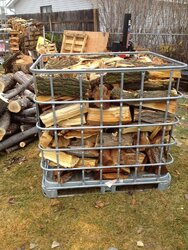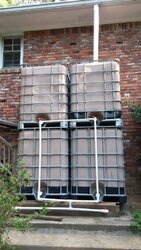I’m going to start using IBC tote frames to hold my firewood while it dries. I know some of you dry your wood this way because I’ve seen pictures, so I want to benefit from your experience.
1) Do you stack the wood properly or just jumble it in as you throw it off the splitter?
2) With however you do it, how long does it take to get most wood under 20% MC (in other words, is it as fast as stacking it in rows)?
3) If you stack, how tightly do you fill the tote? I’m cutting at 15” long, which technically gives me 3 rows fitting in an IBC frame. However, they’d be pretty much end-to-end in there. 2 rows would leave a >10” airspace between the rows, which might aid drying.
Is there anything else I should think about?
1) Do you stack the wood properly or just jumble it in as you throw it off the splitter?
2) With however you do it, how long does it take to get most wood under 20% MC (in other words, is it as fast as stacking it in rows)?
3) If you stack, how tightly do you fill the tote? I’m cutting at 15” long, which technically gives me 3 rows fitting in an IBC frame. However, they’d be pretty much end-to-end in there. 2 rows would leave a >10” airspace between the rows, which might aid drying.
Is there anything else I should think about?



